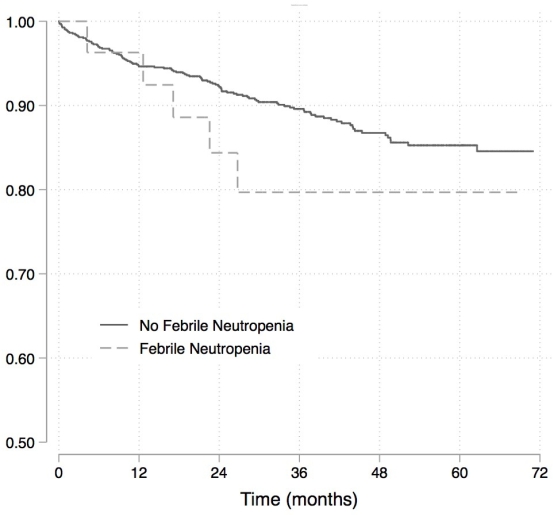The Impact of Induction Agent on Development of Febrile Neutropenia Following Kidney Transplant
Medicine, Columbia University Medical Center, New York, NY.
Meeting: 2018 American Transplant Congress
Abstract number: D145
Keywords: Infection, Kidney transplantation, Neutropenia
Session Information
Session Name: Poster Session D: Kidney Infectious
Session Type: Poster Session
Date: Tuesday, June 5, 2018
Session Time: 6:00pm-7:00pm
 Presentation Time: 6:00pm-7:00pm
Presentation Time: 6:00pm-7:00pm
Location: Hall 4EF
Neutropenia is common after kidney transplant (KT), usually due to medication side effects (induction agents maintenance medications, antibiotics), and is associated with worse patient and graft survival. Febrile neutropenia (FN) is common in patients receiving chemotherapy for cancer. There are few data on the risk of developing FN after KT, and the impact of induction medications on this risk.
Methods: We performed a single-center study of 1002 KT alone recipients from 2012-2016. All patients received induction with thymoglobulin 6 mg/kg, Campath 30 mg x 1 or basiliximab 20 mg x 2, and underwent early steroid withdrawal. Maintenance immunosuppression was the same in each group (tacrolimus/MMF). Neutropenia was defined as absolute neutrophil count < 1000, fever as T >38.0C.
Results: Demographics of the 1002 recipients are shown in the table.
| Thymoglobulin (n=414) | Campath (n=461 | Basiliximab (n=127) | |
| Age (yr) | 52.1 | 51.7 | 51.0 |
| Female | 40% | 39% | 41% |
| White | 39% | 45% | 55% |
| Black | 20% | 17% | 14% |
| Hispanic | 26% | 23% | 21% |
| Living donor | 42% | 55% | 65% |
| Retransplant | 10% | 13% | 32% |
Neutropenia was more common with Campath (41.9%) compared with thymoglobulin (34.5%) or basiliximab (22.0%) (p<0.001; p=0.02 for Campath vs. thymoglobulin). The incidence of FN was 3.62% with thymoglobulin vs. 2.39% with Campath vs. 1.57% with basiliximab (p=NS). Median time to FN was 9.1 months with thymoglobulin and 5.6 months with Campath (p=NS). Patient survival was similar in patients who developed FN compared with those who did not develop FN.
Conclusions: Neutropenia is more common with Campath compared with thymoglobulin and basiliximab. However, the incidence of FN is similar with each of these agents, and there is no difference in the timing of FN episodes after KT with Campath compared with thymoglobulin. Further study is needed regarding risk factors for the development of FN after transplant.
CITATION INFORMATION: Dube G., Husain S., Cohen D., Mohan S. The Impact of Induction Agent on Development of Febrile Neutropenia Following Kidney Transplant Am J Transplant. 2017;17 (suppl 3).
To cite this abstract in AMA style:
Dube G, Husain S, Cohen D, Mohan S. The Impact of Induction Agent on Development of Febrile Neutropenia Following Kidney Transplant [abstract]. https://atcmeetingabstracts.com/abstract/the-impact-of-induction-agent-on-development-of-febrile-neutropenia-following-kidney-transplant/. Accessed December 31, 2025.« Back to 2018 American Transplant Congress
